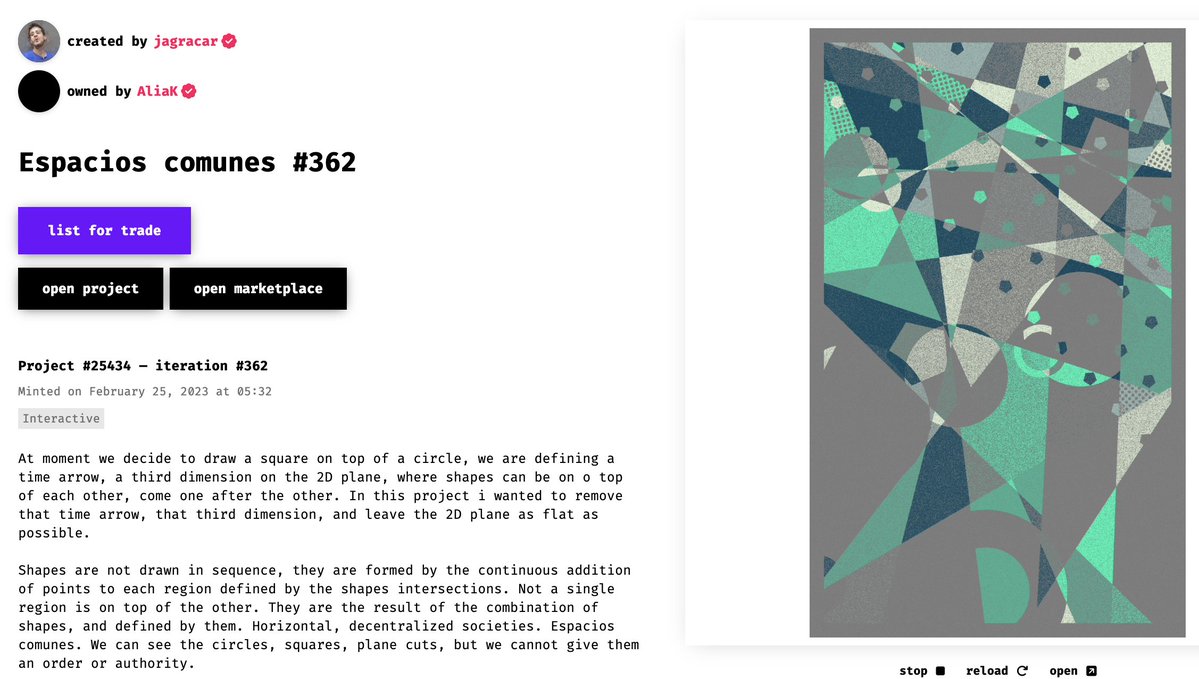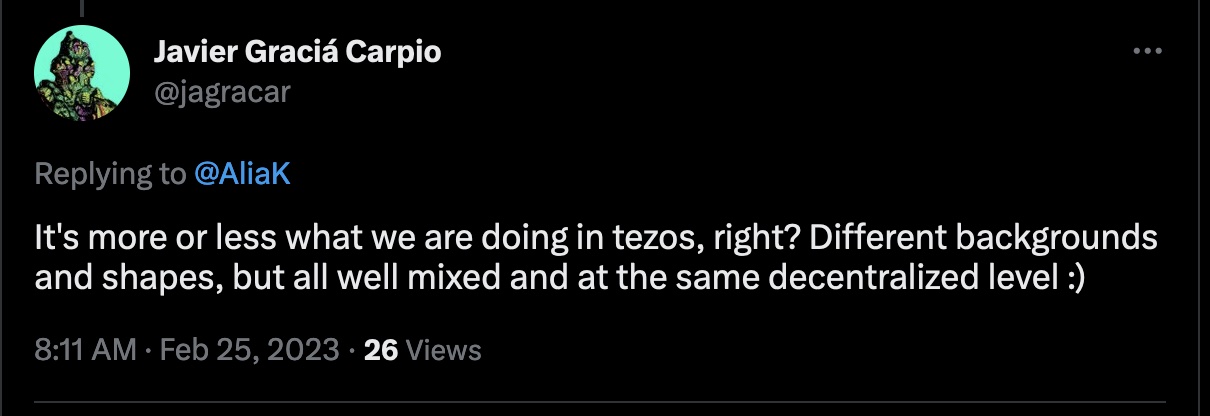Espacios comunes as places of connection
Espacios comunes is a code-based, generative artwork by Javier Graciá Carpio (jagracar) minted on fx(hash), with the main version plus 512 iterations. The drawing is made using P5.JS, with pixel sorting and added noise / texture via GLSL shaders.

Jagracar. Espacios comunes. 2023. Digital artwork. Variable sizes. Reproduced from Fx(hash), https://www.fxhash.xyz/generative/slug/espacios-comunes.
Initially I saw digital landscapes built up from atoms/points, forming over time. After reading the artist's description and translating the title as common spaces, I interpret the artist's intention of a collection of spaces as more socially based places. Jagracar describes the work as: "Horizontal, decentralized societies. Espacios comunes. We can see the circles, squares, plane cuts, but we cannot give them an order or authority" and further explained via a tweet: "It's more or less what we are doing in Tezos, right? Different backgrounds and shapes, but all well mixed and at the same decentralized level :)" By adding the social aspect to these spaces, Jagracar has reinforced their use as places — this fits with my research on the exploration of the blockchain as not a placeless space, it is actually a Place in the architectural and geographical theory sense, due to the communities active on it and social aspects. Jagracar's views of Espacios comunes could be seen as the topographical map, extending from and sitting alongside Paul Baran's decentralised network topologies diagram (as used by Vitalik Buterin also), to see the societies' view — another view of Haraway's tentacular thinking, where the interconnections between nodes/communities are closer, as with Tezos and its communities themselves.

Jagracar. "Tweet". 2023. Image of tweet reproduced from Twitter, https://twitter.com/jagracar/status/1629227616090587137?s=20.

AliaK. Paul Baran's network topology map, also used by Vitalik Buterin. 2022. Image screenshot reproduced from AliaK.com, http://aliak.com/content/specture-topology-and-context.
Espacios comunes is a durational work — the points creating the forms appear over time, drawn using P5.JS code. The points are displayed simultaneously, growing in intensity, so you see the whole image appear gradually, rather than it building different areas of the drawing sequentially — aligning to a progressive scan rather than interlaced scan; the digital over the analog. Texture is added via the addition of noise from the shaders, which are also doing some pixel sorting. In this world communities have grown in parallel, together, rather than sequentially where they would be waiting for one to start and finish before the next can be formed. The work uses varying colours from tuned palettes. Though it's described as a flat, 2D work from a conceptual perspective, the use of colours and textures applied via the shader provides dimensional and tonal aspects to the work.
The work is bounded by fixed borders, yet each iteration has a different support size. Instead of making a uniform dynamically sized work, the overall collection of iterations provides the variation in dimensions. Each collector's iteration depicts a new layout of the places, a new configuration of social interactions, new perspectives. This adds a multi-dimensional aspect to it. There are control commands which can be used to adjust the dimensions of the work, if the viewer wishes to interact with the work, in the same way that members of the communities can interact with and adjust the sizes of the communities and their involvements.
Overall, a beautiful debut for the artist on fx(hash) platform. Jagracar's earlier works can be found on Teia also via https://teia.art/jagracar
View the work and its iterations at https://www.fxhash.xyz/generative/slug/espacios-comunes
::: these notes / analysis are based on the context of my specture project research
::: also published at https://www.fxhash.xyz/article/espacios-comunes-as-places-of-connection and https://medium.com/@aliak/espacios-comunes-as-places-of-connection-d8c00...
Haraway, Donna J. 2016. Staying with the Trouble: Making Kin in the Chthulucene (Experimental Futures). Durham and London: Duke University Press.
Buterin, Vitalik. 2017. "The Meaning of Decentralization." Medium. https://medium.com/@VitalikButerin/the-meaning-of-decentralization-a0c92....
Rand Corporation. 2022. "Paul Baran and the Origins of the Internet." Rand Corporation. Accessed on 15 September, https://www.rand.org/about/history/baran.html.
::: artists:
::: internet communication:
::: location:
- 2141 reads
